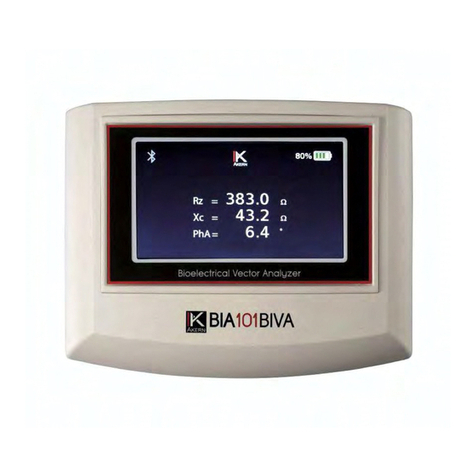
Rev. 0 03/2019 Page 9to 36
BIA101BIVA
Comply with the recommendations and warning symbols in the manual and
the messages displayed on the device.
•Do not use the device close to water and do not pour water onto it.
The IPX0 protection class does not protect against penetration by liquids and the device
might be irreversibly damaged, without service or warranty cover.
•Do not place the device on unstable surfaces or trolleys.
The device may fall and be seriously damaged.
•To ensure operation of the device throughout its life-cycle, avoid exposure to temperatures
above 60°C and therefore do not place it near radiators or in containers lacking adequate
ventilation.
•During storage,relative humidity in the environment must not exceed 95% without condensation.
•Never apply any weight to the battery charger cable,the patient cable,the measuring electrodes
or the device itself.
•Do not place the device in an obstructing position when it is being charged.
•Do not plug any object into the multipole socket of the battery charger/patient cable.
•Use only the accessories supplied.
•Do not try to repair the device: it does not contain any parts which can be repaired by unskilled
staff.
•Maintenance and repair must only be performed by qualified technical personnel.
All tampering by unauthorised staff causes expiry of the warranty and the certification. This could
damage the device beyond repair and put the user and the patient being analysed at risk.
•The device must only be charged using the PDU supplied.
•Do not recharge the device when:
the battery charger power cord shows signs of damage or pinches;
the device does not work properly although operating instructions have been followed
correctly;
the device has been dropped and/or the container is damaged;
the device shows clear signs of malfunction that may require technical servicing.
•Do not replace batteries without contacting Akern or an authorized dealer. Lithium batteries
have a high explosion risk if not correctly recharged.
Remark:
To replace the battery contact the Technical Support Service or Authorised Dealer
Caution! The lithium-ion battery may explode if handled incorrectly.
Do not remove it or throw it away.
Lithium-ion batteries must be disposed of in compliance with statutory legislation.
Caution: use only BIATRODES electrodes, as per manufacturer’s indications. The
use of different electrodes may interfere with measurements and is defined as an
UNACCEPTABLE risk. The user is completely responsible for any use of different
electrodes.




























